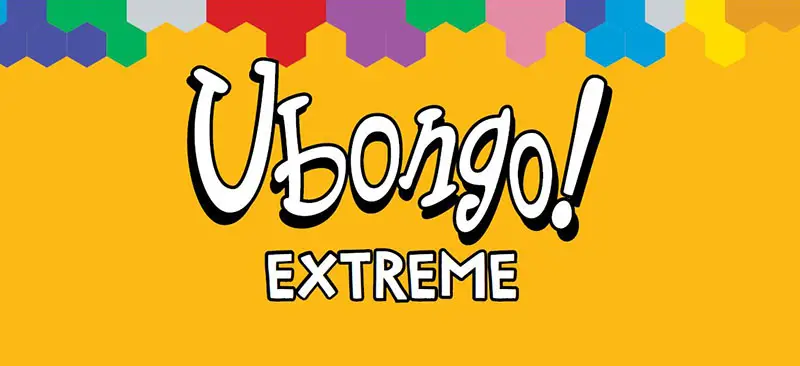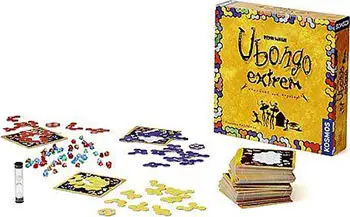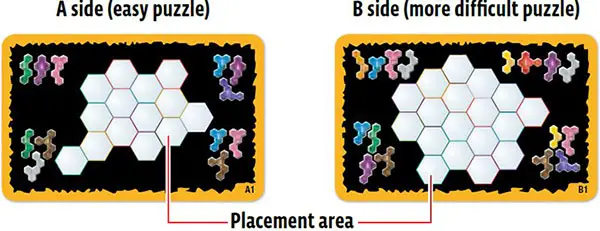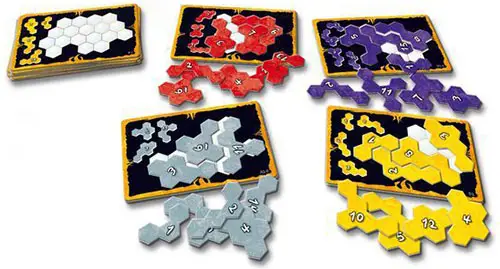
Each player receives one set of ten tiles. At the beginning of each round, each player also receives a new puzzle card.
During a round, all of the players simultaneously try to cover the light-colored placement area of their puzzle cards completely with the specified tiles, with no part of any tile sticking outside of the placement area.
The first player to solve his or her puzzle yells "Ubongo!" Then, this player starts counting down from 20 to zero, while the other players continue trying to solve their puzzles.

Components
- 32 Puzzle cards (with 256 different puzzles)
- 4 Sets of 10 tiles
- Instructions
Object of the Game
All players who solve their puzzles before the countdown ends, including the first player, earn one victory point. These players keep the puzzle cards that they solved (off to the side) to signify their earned victory points.
The round ends when the countdown ends; any players who did not solve the puzzle in time do not earn any points, and must give their puzzle cards to the first player as an additional victory point.
The player with the most victory points after eight rounds wins.
Setup
Take the 32 puzzle cards from the box. Each puzzle card has two levels of difficulty: On the A sides are the easy puzzles, which require three tiles to solve.
On the B sides are the more difficult puzzles, which require four tiles to solve. For the first game, we recommend using the A sides with the easy puzzles.

In your game, you will need a different number of puzzle cards depending on how many players there are:
- 2 Players: 16 puzzle cards
- 3 Players: 24 puzzle cards
- 4 Players: 32 puzzle cards
For a game with fewer than four players, place the cards that are not needed back into the box.
Flip all of the puzzle cards needed for your game so that the sides with your chosen difficulty level are face down, shuffle them, and place the stack in the center of the table; the puzzles you will be attempting to complete must initially be hidden.
Each player receives a set of ten different shape tiles. If there are fewer than four players, return the unused tiles to the box.

Game Play
The game lasts eight rounds. In each round, you solve the puzzle using the tiles specified on the card. For the first round, use the tiles pictured in the upper-left corner.
For the second round, use the tiles pictured in the upper-right corner. Then, use the tiles pictured in the lower-left corner, and then, the lower-right corner.
For the fifth round, use the upper-left corner tiles and proceed in the same way until you use the lower-right corner tiles for the eighth round.

Round Sequence
Each player takes one puzzle card from the stack and places it in front of himself or herself. All of the players simultaneously turn their cards over to show the sides with your chosen difficulty level at the same time.
Ready, set, go! Now everyone tries to fit the tiles specified for this round exactly into the light-colored placement area on their own puzzle cards.
This means that the area must be covered completely - the tiles may not stick out over the edges of the placement area and may not overlap other tiles. To fit the pieces, players may rotate and flip the tiles over.

As soon as one of the players has completed his or her puzzle, he or she shouts "Ubongo!" and counts down loudly (and not too fast!) from 20 to zero if the simple puzzles are being used, or from 30 to zero if the more difficult puzzles are being used.
The players may also agree on a different countdown number before the game.
The player who completes his or her puzzle first keeps the puzzle card at the end of the round, which signifies one victory point.
The other players continue playing while the first player is counting down. Any player who solves his or her puzzle before the countdown reaches zero can keep the card as a victory point at the end of the round.
When the countdown reaches zero, all of the players must immediately stop. Players who did not complete their puzzle must hand over their cards to the player who solved his or her puzzle first. The cards count as victory points at the end of the game.
New Round
All players take a new card from the stack and try again to solve their puzzles as fast as possible.
End of the Game
The game ends after eight rounds (i.e., after the round in which the stack of puzzle cards is used up). Now each player counts his or her puzzle cards, which are each worth one victory point.
The player with the most points wins. If there is a tie, the tied players play one more round.
They take the top puzzle card of the players to their lefts and use the tiles pictured in the upper-right corners.
The player who finishes first in this final round wins the game.
Solo Variant
If you want to play Ubongo Extreme by yourself, you will need a clock or stopwatch.
Try to complete as many puzzle cards as possible in five (or ten, or 20) minutes. Another solo variant consists of measuring the time you need to complete five (or ten, or 20) puzzles.
If you get stuck on a puzzle card, you can put it aside and draw a new puzzle card.
Write your results down and try to establish a new record each time you play.
Increased Difficulty
Play eight rounds as explained before. However, only the first player to complete the puzzle in each round gets to keep his or her puzzle card as a victory point.
Continue Reading


